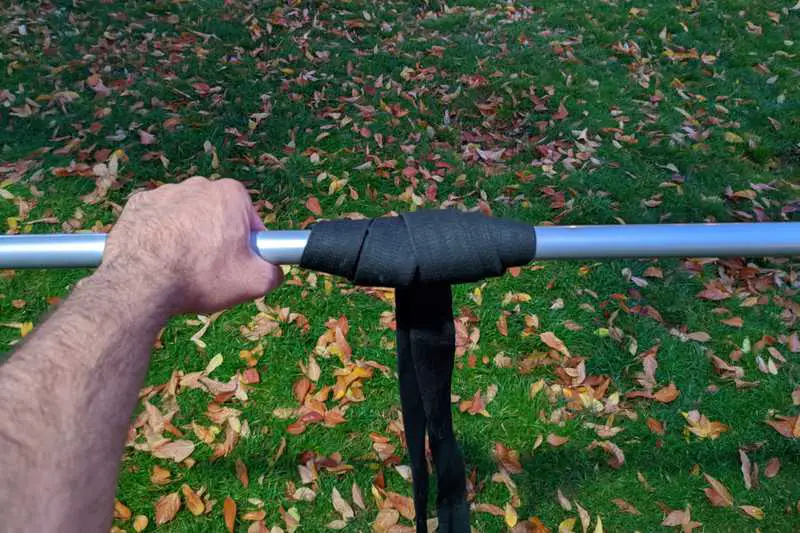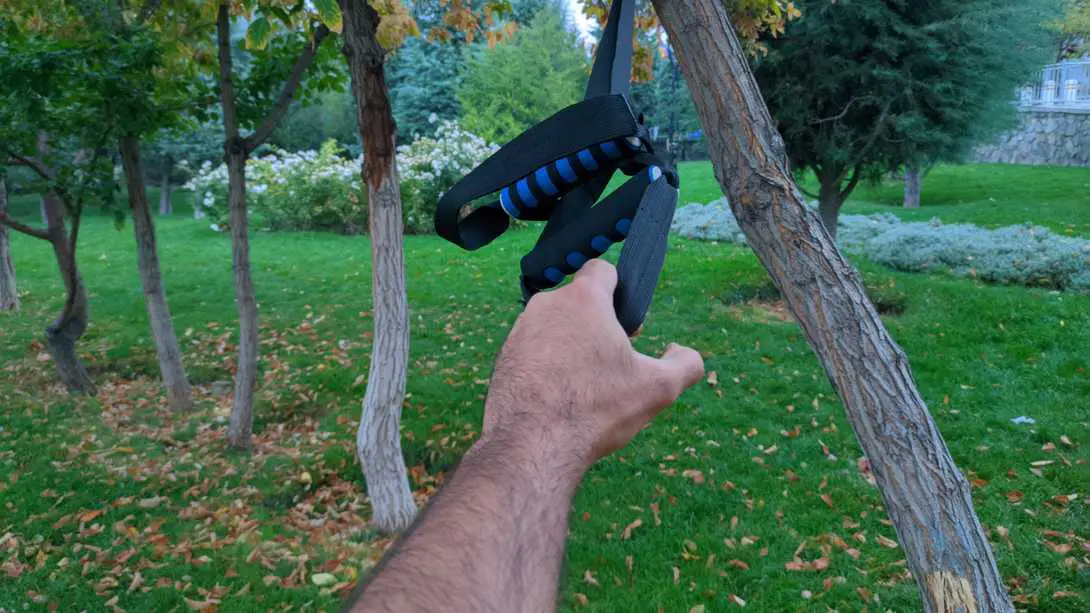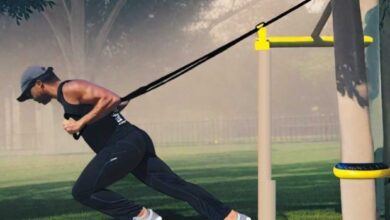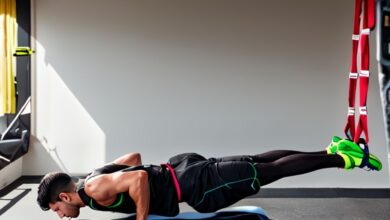Forearm muscles are small and engaged in almost every activity. So, many people do not bother to exercise them separately. Bodyweight exercises are multi-jointed type of training. Naturally, forearms and wrists are trained indirectly during different upper body exercises, but still, we can perform isolated TRX forearm exercises to improve weak areas.
Grip strength is crucial in any upper-body exercise. A weak grip affects the quality of practice in other body parts. You might have experienced it in some activities, your main muscle can handle that, but your hands are not strong enough to hold on to it. For example, in TRX pull-up and TRX back exercises that a larger portion of the body weight is suspended from hands, a weak hand grip prevents thoroughly exhausting those muscles.
A typical example of this phenomenon in weight lifting happens during deadlift. The deadlift strap helps to hold on to the bar during the move. So, in case your grip strength is not good enough and impacts the quality of the training, adding isolated wrist and forearm exercises to the routine will be a suitable choice.
Forearm exercises with free weights are more convenient than TRX forearm exercises. There are some degrees of fraction in TRX handles when trying to twist them from wrist joints. Free weights have more freedom of movement in this case.
Table of Contents
Biomechanics of Wrist and Forearm in TRX Forearm Exercises
Muscles of the wrist are located in the forearm area, and long tendons attach those muscles to a bone in the hand. The wrist joint itself is very vulnerable to injury, because there is no muscle to support the area.
The wrist can make four movements: flexion, extension, radial deviation (bending the wrist towards the thumb), and ulnar deviation (bending the wrist towards the end finger). Forearm, wrist, and hand can also rotate to the pronated or supinated position using the pronator and supinator muscles of the forearm. Take note that the wrist does not have rotational movement, but moves along with the forearm.
We can train TRX forearm exercises in four movements of the wrist: flexion, extension, radial deviation, ulnar deviation, and two rotational movements of the forearm.
There are six muscles in the forearm to flex the hand. Three of them are responsible for flexing the wrist, and three others are attached to phalanges (finger bones) through tendons. The latter group assists with flexing the wrist and the respective fingers and thumb.
We can conclude that strengthening the forearm, wrist, and finger muscles is a collaborative exercise. Hence, it is better to train them all together.
TRX Wrist Exercises
A note of caution – There is a drawback with these exercises, and that is due to the fraction between TRX handles and straps, which may add to the wear and tear of the suspension straps over time. So, practice with caution. If you notice that this constant rotation of handles is damaging the straps, it’s better to avoid them and use weights or other no-equipment forearm exercises.
TRX Wrist Curl
Also known as TRX forearm curl, TRX wrist curl has a body positioning similar to the TRX bicep curl.
- Grasp TRX handles with underhand (supinated) grip.
- Shift body weight backward.
- Flex your wrists and curl your hands toward your forearm.
- Extend your wrists.
TRX Reverse Grip Wrist Curl
Body positioning in TRX reverse grip wrist curl is similar to TRX wrist curl but uses overhand (pronated) grip, and curls the back of your hand towards the forearm.
There is a difference between TRX reverse grip wrist curl and TRX reverse grip bicep curl. In TRX reverse grip bicep curl, you are still exercising the biceps and not triceps, whereas in TRX reverse grip wrist curl, you are exercising the extensional wrist muscles. As a result, ensure that during TRX reverse grip wrist curl, you exercise the opposite muscles to TRX wrist curl.
TRX Eccentric Wrist Curl
We can perform all normal TRX forearm exercises in eccentric system. In eccentric muscle contraction with wrist, we overload the wrist muscles at the negative phase of the TRX forearm curl. The same principle is also applied to TRX eccentric wrist curl.
TRX Pelican Wrist Curl
Body positioning in TRX pelican wrist curl is similar to TRX pelican curl, except instead of biceps, we curl wrists. All variations of pronated, supinated and hammer grip are applicable, but underhand grip is the best suitable for TRX pelican wrist curl.
TRX Grip Strength Exercises
As it was explained, grip strength and wrist muscles can be trained together in a TRX forearm exercise. Here, we introduce some specific TRX grip strength exercises.
TRX Fingers Curl
Starting position in TRX fingers curl is similar to TRX bicep curl. Hold TRX handles or foot cradles with fingers, and curl fingers to the closed state.
TRX Dead Hang
Body positioning in TRX dead hang is similar to TRX pull-up, but in TRX dead hang instead of lifting your body up, stay in the hanging position for as long as you can. In TRX dead hang, the maximum resistance is in the vertical hanging position. However, we can make the exercise easier by placing feet on the ground and a bit forward, similar to TRX inverted row.
TRX Dead Hang – One Hand at a Time
This is another variation of TRX dead hang. How to do TRX dead hang—one hand at a time:
- Hold both TRX handles.
- Place your feet onto the ground and in front of you in a seated position.
- Loose one hand grip and shift your body weight onto the other hand.
- Hold on as long as you can.
- Make your other hand grip firmer and loose this hand.
- Hold on as long as you can.
TRX Fat Grip
The idea behind using fat grip is to prevent fingers from locking and thus, you will have to grip harder in order to hold on to the bar or handles. We can use fat gripz both for barbels and for TRX system. The larger the TRS fat grip, the more pressure you have to put on it during the exercise. Also, by placing your thumb behind the handle, you put more pressure on four other fingers. We can also perform TRX dead hang with fat gripz.
TRX Globe Gripz
Globe gripz are also similar to fat gripz except with the shape of the globe, and they add different variations to TRX forearm exercises. You can install globe gripz on TRX handles or the foot straps. We can use globe gripz in different TRX exercises. For example, we can perform TRX dead hang with globe gripz.
Compound TRX Forearm Exercises
Compound TRX forearm exercises are not specifically designed for wrist and hands, but due to the biomechanics of the exercise, they put a secondary pressure on the forearm muscles. Particularly, if you don’t want to train your forearms separately, including them in the daily TRX program can compensate for that.
- TRX Reverse Grip Bicep Curl
- TRX hammer curl
- TRX zottman curl
- TRX twisting curl
- TRX pull-ups
- TRX inverted row
For instructions about the exercises above, please visit TRX bicep workouts.
Pro tip: Sometimes the primary target of an exercise is not forearm muscles, yet your grip gives out before you can properly work out your primary muscle. In that case, using lifting strap can help to perform the exercise.
TRX Forearm Exercises with Weights
TRX forearm exercises can be performed with weights instead of body weight. In many variations, just use the TRX anchor point to hold on to the weight and use handles to perform different TRX forearm exercises.
TRX Wrist Roller
TRX wrist roller is another variation of TRX forearm exercise that requires weight and a bar. At one point, attach the TRX anchor point to the weight, and at the other, twist the strap a few turns around a bar. Then, by revolving the bar, we can lift the weight up.

Pay attention that as the roll of the strap around the bar gets thicker, the exercise becomes harder. Once the weight reaches the top, roll out the strap by revolving the bar in the opposite direction. This is the eccentric phase of this forearm exercise. So, prevent the bar from slipping in your hands and roll out the strap slowly while feeling the burn in your forearms. This is also a new training system; it separates concentric and eccentric phases of movement. During the wrapping of the TRX strap it is concentric, and during the unwrapping phase it is eccentric.
Forearm muscles are composed of extensors and flexors. One group takes the wrist up and the other group takes it down. With TRX wrist roller, we can train both muscle groups. The difference between the two is determined by how you wrap the strap around the bar. If the strap is towards your body, you are working out your forearm flexors; if it is behind the bar, you are training forearm extensors. We can practice one set with extensor muscles and another set with flexors, or do a few sets with extensors and then a few sets with flexors. The training program determines this.
There is a tricky aspect in performing wrist roller with TRX. You should find a way to prevent the TRX strap from sliding off the bar. For convenience, you may also consider purchasing a wrist roller that can be used as home gym equipment or in a public gym.
TRX Workout Wrist Pain
Biomechanical and physiological demands on calisthenics exercises require high-functioning wrist joints. Wrist joints are responsible to bear a large portion of the body weight and keep the balance in TRX workouts. TRX wrist pain can occur as a result of overuse, overextension, repetitive impact on wrist joints, or a sharp twist of the wrist under pressure, especially in those not used to bodyweight exercises.
Propper warm-up and stretching before exercise, along with dedicated TRX forearm exercises, are crucial to prevent TRX wrist pain.
Oftentime, slight TRX workout wrist pain can be treated easily and with therapy. Thereby, it is a best practice to protect your wrists against degenerative damage. Wearing wrist wraps improves stability of the wrist joints and reduces the chance of TRX wrist pain.
Sometimes TRX handles wear out due to overuse. Also, using homemade TRX with bare PVC handles can hurt hands. Gymnastic gears are a suitable add-on to protect your hands against twisting motions on handles and add an extra layer of protection. They protect palms while allowing complete freedom of movement.
Common Questions about TRX Forearm Workouts
How Do I Make My Forearms Stronger without Weights?
There are plenty of ways to strengthen forearms without using weights. Using TRX forearm exercises is one of them. Alternatively, there are other bodyweight forearm exercises, such as finger push-ups, towel pull-up, crab walk, etc.
Do You Need to Train Forearms Directly?
It depends on the purpose and general condition of the forearm muscles. In general, if you want bigger forearms or practice for certain sports like rock climbing, work on the forearm directly. If you only need a strong enough grip for other exercises, usually TRX compound forearm exercises do the work.
Should I Train Forearms Every Day?
Typically, it is recommended to recover for 72 hours before hitting the same muscle group again. The forearm has a higher percentage of slow-twitch muscle fibers, can be trained more frequently and recovers faster. Daily TRX forearm workout is not ideal for a standard training regimen. You naturally train your forearms during other upper body exercises. Besides, tired forearms affect the quality of other exercises. Up to three times a week should be enough.
How Many Reps of Forearms Should You Do?
Having a higher percentage of slow-twitch muscle fibers, forearms respond better to higher repetitions. Aim for 3 to 5 sets of 10 to 20 reps per set, and take less rest between sets. A slight pause at the top of each repetition improves effectiveness of the exercise.
How Many Forearm Exercises Should I Do?
Opt for 2 – 4 TRX forearm exercises to perform each week. It is recommended to add TRX forearm exercises to the end of your session. If you exhaust your forearms early in the session, you will not be able to perform other exercises properly.
Does Squeezing a Tennis Ball Build Forearms?
Squeezing a tennis ball is effective for grip strength, but it is more of a beginner type of forearm exercise. Fat gripz and globe grips provide more effective TRX forearm exercises.





